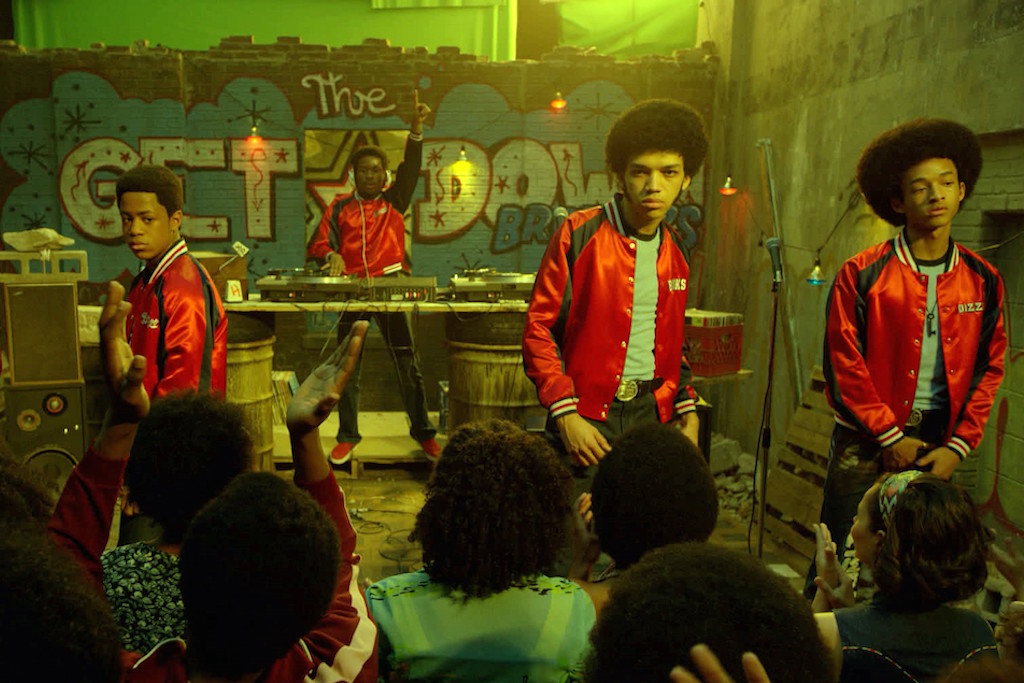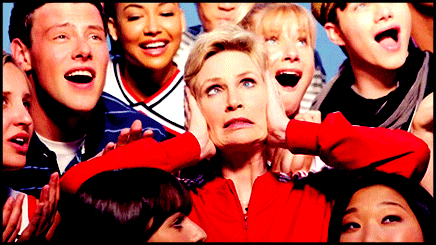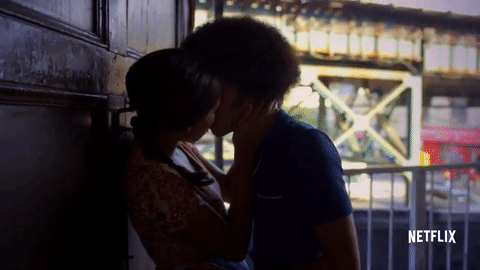Breaking Down The Magnificent Camp And The Disappointing Crap Of ‘The Get Down’
This show is definitely made by Baz Luhrmann.

In Netflix’s The Get Down, the new series from that curator of bombastic camp, Baz Luhrmann, the eponymous phrase refers to the best bits of any song — the parts you can get down to. Everything else, the rest of the crap on the record, is the “wackness”. The get down is actually an apt metaphor for Luhrmann’s new disco drama too — the show is full of great honking gems of brilliance, pathos and glorious melodrama buried in a lot of Luhrmann-esque crap.
Set in The Bronx, sweaty and steaming in the summer of 1977, The Get Down centres on Ezekiel (Justice Smith), a young man with a talent for writing who teams up with an aspiring DJ (Shameik Moore) to learn the art of the get down from real-life hip-hop revolutionary Grandmaster Flash (played here by Mamoudou Athie, though Flash serves as a producer on the series).
The Get Down has been touted as the tale of hip-hop’s birth, but it’s more like a chronicle of a community: Zeke, his friends and their families are at turns thriving and just barely surviving in the sometimes harsh, operatic (fictional) South Bronx that Lurhmann and his co-creator Stephen Adly Guirgis have protracted from actual history.
If Luhrmann’s career is as theatrical as his output, then The Get Down is his 11 o’clock number: grand and show-stopping, though imperfect. Plagued by production dramas and reportedly costing a scandalous $120 million to make, The Get Down is being released in two parts and the first six episodes, now available on Netflix, are a mixed bag. But those moments of brilliance, the absurd drama and prophetic pathos at which Luhrmann excels, are well worth the “wackness” that surrounds them.
–
Luhrmann, Murphy And The Mixed Bag Of TV Camp
The Get Down is Luhrmann’s first foray into television, but contemporary TV is no stranger to his particular blend of stylised extravagance. Luhrmann is perhaps spiritual companion to the extraordinarily prolific Ryan Murphy (Glee, American Horror Story, Nip/Tuck), notorious camp auteur for the small screen. Of course, neither of these men invented camp, but they have drafted its subversive, subcultural style extensively to produce work that is unusual and exciting for television.
Both populist auteurs, Luhrmann and Murphy borrow from cult camp history for their mainstream output. Luhrmann aims for the opulent fantasy of golden-age velvet-curtain melodrama and the exaggerated absurdity of the Hispanic telenovela. Murphy dabbles more in the trash of ‘80s mean teens and the filth of ‘70s horror and gore. Still, both filmmakers blend the so-bad-it’s-good sensibility of “campness” with the prophetic worldview of camp. As Slate’s J. Bryan Lowder suggests, this style is “always looking forward, gently hinting at a time yet to come when things might be, if not perfect, at least otherwise”.
The New Yorker’s Emily Nussbaum once described Ryan Murphy as “an irritant, like cayenne pepper”, able to create excellent beginnings of TV series before “driving his inventions off a cliff”. She’s not wrong: Murphy’s shows are famous for their inconsistency and their often poor taste. But perhaps Murphy, in his desire to push the boundaries of acceptability, is aiming for the kind of camp epitomised by treasured director John Waters, who once said of his “filth” style: “the right kind of people understand it and it frightens away the timid”. Murphy doesn’t always win over critics or the public at large, but perhaps the “right kind of people” appreciate his bold, acerbic camp for the indefatigable boundaries it pushes in television.

Likewise, Luhrmann has a somewhat inconsistent track record on film. Australia, his mid-century drover’s epic starring Hugh Jackman and Nicole Kidman, was an infamous flop, and his long-awaited Great Gatsby received mixed reviews. (Though, really, there’s no denying that delirious shirt-throwing scene). Critiques of Luhrmann’s work are derisive of his extravagance, which many perceive to be tasteless. Certainly Luhrmann has always walked a fine line between just enough and too much; but when he gets it right, it’s fabulously affecting.
Murphy and Luhrmann use the camp aesthetic — exaggeration, theatricality, romance and the grotesque — to ends both good and bad, and when they fail they are roundly criticised. But the boldness of their perspective, which hints at something “otherwise”, something more than the norm, is still worth watching regardless of their success rate.
So it is with The Get Down — Luhrmann’s premiere plunge into the deep well of TV production. Now more than ever, when so much television is being made, on all different platforms and for myriad ever-shrinking niches, a challenging point-of-view is something to be valued on the small screen.
–
The Best (And Worst) Of The Get Down’s “Part One”
Curiously, one of The Get Down’s greatest struggles is Luhrmann himself. Under his direction, the pilot — the only episode he directed — was rendered a confusing 90 minutes of clashing bests and worsts.
Much of what doesn’t work about the show is in his aesthetic: drastic tonal shifts, mystical exoticisation of “the other”, and a tendency to view certain tried storylines (star-crossed lovers, eccentric villains, warring ideologies manifest in gang clashes) with rose-tinted grandeur. But the bests are Luhrmann’s, too. His poignant reflections on youth, success and the real magic of art are what gives The Get Down its incontrovertible bigheartedness.
The show’s beating heart is Ezekiel, played with tenderness and charisma by Justice Smith. Smith — who ducks and grins under his furrowed brow — is always scribbling and rapping and prophesising to his teacher, his friends, and to the love of his life, disco diva wannabe Mylene (a radiant Herizen Guardiola). Though he mumbles his poems with the guttural growl of a pack-a-day smoker, his tender delivery (and that smile) makes even the most pretentious preaching seem unaccountably charming.

It’s this talent that gets him noticed by Shaolin Fantastic (Moore), a kung-fu fighting graffiti aficionado who dreams of being the next DJ superstar. He enlists Ezekiel as his wordsmith, spitting rhymes as Shao spins the get down under the instruction of their “sensei”, Grandmaster Flash. Zeke and his friends (Skylan Brooks, Tremaine Brown Jr. and an adorable Jaden Smith) join Shao to form “The Fantastic Four Plus One”, on a journey to become the next big crew as South Bronx evolves from disco to hip-hop.
As evidenced by the show’s unnecessary framing device — where a grown-up MC Ezekiel (Hamilton’s Daveed Diggs) raps about his upbringing in the Bronx (to songs written by Nas) — the crew’s journey to hip-hop stardom is the main event. But swirling around them are various subplots involving Mylene’s disco dreams and her conservative preacher father (Giancarlo Esposito, overdoing it), a Blaxploitative turf war between drug-peddling gangs, and a political corruption chronicle involving the gentrification of the South Bronx. In true Luhrmann style, it’s a veritable pick ‘n’ mix of melodrama.
If it’s odd to see the rhythm of black and Hispanic disco and hip-hop tapped out by a white Australian man — albeit one with a flair for the drama and revolution inherent in those musical styles — it’s even weirder to see it all melded with retro kung-fu mysticism, tattered operetta, and small-time political espionage. It all goes together about as well as petrol and a lit match: sure, there are fireworks, but it’s fucking dangerous.
–
Romance, Violence, And Art
The Get Down‘s two central romances — between Ezekiel and Mylene, and Ezekiel and Shao — are alternately inspiring and infuriating.
With the first, Luhrmann is imitating his success in Romeo + Juliet, but with varying results. Zeke and Mylene are the “star-crossed lovers”, kept apart not by opposing families but opposing musical ideologies (and their own stubborn stupidity). Smith’s dewy-eyed charm and relentless sincerity are reminiscent of Leonardo Dicaprio, still dazzling in Luhrmann’s R+J as an inimitably sympathetic Romeo. Every time Zeke and Mylene meet they begin by spouting modern sonnets so florid you’d swear they’re Shakespeare’s finest, and end screaming about the incontestable difference between OG disco and the get down. Apparently differing music tastes is a mountain no love can conquer. (There are echoes, too, of Bernstein’s West Side Story; the lovers are often conferring on moonlit fire escapes a la Tony and Maria).

Ezekiel and Shao’s romance, their compatibility as DJ and wordsmith, is that age-old temperamental artistic partnership. When not stoned and giggling in smoky, vertigo-inducing hotboxes, the two are forever at odds over their different approaches to hip-hop success. As the show posits: an iron-clad DJ Rule is that “in order to fly, a DJ must trust his wings”. Ezekiel and Shao’s tenuous crew make for some seriously shaky wings. Most episodes end with the two shouting threats at each other (“If you ever see me again, cross the street”) before making up next time to start anew. Shameik Moore is gung-ho as Shao. He delivers every ridiculous line and throws every mysterious kung-fu/parkour move with deep earnestness. Like Smith, he seems to understand that Luhrmann’s aesthetic only works if you’re fully committed.
The series starts out frustrating but builds momentum toward the end of this first set of episodes: proof that the show has legs. Too bad production troubles have delayed the second part of the series where, one hopes, the disparate pieces will slot into place.
Still, those opening episodes contain some gorgeous moments of pure, ingenious camp. The major set piece of the pilot is a disco dance-off, where Ezekiel and Mylene face off against disco-king gangster Cadillac in the pivotal club Les Inferno. The number ends in a bloody shoot-out orchestrated by Les Inferno’s rival gang, the Savage Warlords (a straight-up rip-off of The Warriors right down to the fringed leather vests). In these scenes, Luhrmann seems to have the camera on some kind of fairground ride; he swoops and weaves frantically through dazzling dancers and exploding guns in a manner that’s both sickening and stupendous.
The salvation: the closing shot of a blood-spattered disco ball, which serves as a reminder that Luhrmann is at his best when he lets his bold, witty visuals speak for themselves.
In the next episode, the gangster Cadillac (in a move possibly pilfered from a Tarantino villain) disco dances through the torture and murder of a young Warlord thug. It’s a garrulous, gun-toting shimmy (to disco anthem ‘Superfly’) — a tonal mish-mash that somehow both totally works and totally doesn’t. Here Luhrmann et al stray into Murphy territory: grotesque camp that celebrates gory bad taste.
The show doesn’t always use such a light touch when handling inner-city violence. In a repeating motif throughout the series, Ezekiel raps, still raw with grief, about the murder of both his parents. Again, Smith’s committed performance carries off a moment that could read as cloying but turns out profound. But the show is at its absolute strongest when it’s ruminating on the profundity of art. When it works, Zeke and Mylene are brought together by the salvation that music offers.
In fact, all the characters come together best when they’re creating. Whether it’s Shao and his crew learning the quick fix of the get down with a turntable and a purple crayon, or Jaden Smith’s Dizzee finding his voice (and an unexpected romance) through graffiti, or Mylene and her girlfriends shimmying to ‘Turn The Beat Around’ at the local barber shop, every moment of purest joy in The Get Down has its roots in art’s unrestrained magic.
Considering how conservatives, not just in Australia but overseas as well, are waging a war on the arts, it’s nice to know that someone with a popular platform is championing art’s curative power for the mainstream. It’s a message that renders the series subversive and visionary. In the end, Lurhmann’s suggestive, hopeful camp sensibility is the get down that rules his show.
–
Part one of The Get Down is on Netflix now; part two will drop some time in 2017.
–
Matilda Dixon-Smith is a freelance writer, editor and theatre-maker, and a card-carrying feminist. She also tweets intermittently and with very little skill from @mdixonsmith.